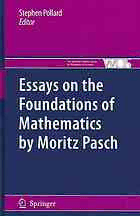Table Of ContentEssays on the Foundations of Mathematics
by Moritz Pasch
THE WESTERN ONTARIO SERIES
IN PHILOSOPHY OF SCIENCE
A SERIES OF BOOKS
IN PHILOSOPHY OF SCIENCE, METHODOLOGY, EPISTEMOLOGY,
LOGIC, HISTORY OF SCIENCE, AND RELATED FIELDS
Managing Editor
WILLIAM DEMOPOULOS
Department of Philosophy, University of Western Ontario, Canada
Managing Editor 1980–1997
ROBERT E. BUTTS
Late, Department of Philosophy, University of Western Ontario, Canada
Editorial Board
JOHN L. BELL, University of Western Ontario
JEFFREY BUB, University of Maryland
PETER CLARK, St Andrews University
DAVID DEVIDI, University of Waterloo
ROBERT DiSALLE, University of Western Ontario
MICHAEL FRIEDMAN, Stanford University
MICHAEL HALLETT, McGill University
WILLIAM HARPER, University of Western Ontario
CLIFFORD A. HOOKER, University of Newcastle
AUSONIO MARRAS, University of Western Ontario
JÜRGEN MITTELSTRASS, Universität Konstanz
WAYNE C. MYRVOLD, University of Western Ontario
THOMAS UEBFL, University of Manchester
ITAMARPITOWSKY† ,Hebrew University
VOLUME 83
Stephen Pollard
Editor
Essays on the Foundations
of Mathematics by
Moritz Pasch
123
Editor
Prof.StephenPollard
TrumanStateUniversity
Dept.Philosophy&Religion
63501KirksvilleMissouri
USA
[email protected]
ISBN978-90-481-9415-5 e-ISBN978-90-481-9416-2
DOI10.1007/978-90-481-9416-2
SpringerDordrechtHeidelbergLondonNewYork
LibraryofCongressControlNumber:2010929951
(cid:2)c SpringerScience+BusinessMediaB.V.2010
Nopartofthisworkmaybereproduced,storedinaretrievalsystem,ortransmittedinanyformorby
anymeans,electronic,mechanical,photocopying,microfilming recordingorotherwise,withoutwritten
permissionfromthePublisher,withtheexceptionofanymaterialsuppliedspecificall forthepurpose
ofbeingenteredandexecutedonacomputersystem,forexclusiveusebythepurchaserofthework.
Printedonacid-freepaper
SpringerispartofSpringerScience+BusinessMedia(www.springer.com)
Preface
MoritzPasch(1843–1930)hasasecurereputationasakeyfigur inthehistoryof
axiomaticgeometry.Lesswellknownarehiscontributionstootherareasoffounda-
tionalresearch.ThisvolumefeaturesEnglishtranslationsoffourteenpapersPasch
publishedinthedecade1917–1926duringthesurgeinproductivityafterhisretire-
ment from the University of Giessen (Justus-Liebig-Universita¨t Gießen). In them,
Pasch argues that geometry and number theory are branches of empirical science;
he provides axioms for the combinatorial reasoning essential to Hilbert’s program
ofconsistencyproofs;heexploresimplicitdefinitio (ageneralizationofdefinitio
by abstraction) and indicates how this technique yields an empiricist reconstruc-
tion of set theory; he argues that we cannot fully understand the logical structure
of mathematics without clearly distinguishing between decidable and undecidable
properties; he offers a rare glimpse into the mind of a master of axiomatics, sur-
veying in detail the thought experiments he employed as he struggled to identify
fundamental mathematicalprinciples;andmuchmore.Thefourteenpapersinthis
volumepresentPasch’smostmaturepositionsonkeyfoundational issuesthathad
occupiedhimfordecades.Theywill:
•
Introduce English speakers to an important body of work from a turbulent and
pivotalperiodinthehistoryofmathematics.
•
Helpuslookbeyondthefamiliartriadofformalism,intuitionism,andlogicism.
•
Show how deeply we can see with the help of a guide determined to present
fundamentalmathematicalideasinwaysthatmatchourhumancapacities.
The book should interest researchers in logic and the foundations of mathematics,
includinghistorians,mathematicians,andphilosophers.
IntranslatingPasch’sGermanintoEnglish,mygoalhasbeentoproduceatext
thatmighthavebeencomposedbyamathematicallyandphilosophicallycompetent
writerwhosefrstlanguageisEnglish.Imentionthissoreaderswillbeawarethat
myerrorswillgenerallynotbeinthedirectionofexcessiveliteralness.Ihavemade
no effort to produce a text from which the original German can be mechanically
reproduced.TheresultofsuchaneffortisunlikelytobeidiomaticEnglish.Readers
shouldalsobeawarethatIhavesilentlycorrectedsomeobviousmisprints.Whenit
v
vi Preface
(cid:2)
isclearbeyondanyshadowofadoubtthat,forexample,Paschmeantl ratherthan
(cid:2)
λ, I do not interrupt the narrative with an explanatory note. I have occasionally
provided descriptive section titles where Pasch has only numbers or only generic
headings that give no hint about the contents. One last liberty: I have rendered in
EnglishthetitlesofGermanworkscitedbyPasch.Readerswhoturntothisvolume
becausetheyhavelittleornoGermanmayfin thishelpful.
For a period of weeks, my colleague David Gillette was subjected to daily, if
nothourly, questionsabout Pasch’sGerman. Iamgratefulforhishelp.Ialsoowe
specialthankstoFlorenceEmilyPollardwho“wantedtoseemewriteabook.”
Kirksville,Missouri,USA StephenPollard
February2010
Contents
Translator’sIntroduction ........................................... 1
0.1 PaschofGiessen ........................................... 1
0.2 ChainsandLines........................................... 3
0.3 ExistenceofLines.......................................... 4
0.4 ExtractingLinesfromLines.................................. 6
0.5 JustifyingInduction ........................................ 8
0.6 InitialSegments............................................ 9
0.7 ConformityandAbstraction.................................. 11
0.8 FiniteOrdinals............................................. 12
0.9 AdditionandMultiplication.................................. 15
0.10 HowMuchArithmetic? ..................................... 18
0.11 ToJustifytheWaysofPeanotoMen .......................... 23
0.12 EmpiricistArithmetic? ...................................... 25
0.13 IdealDivisors.............................................. 30
0.14 ImplicitDefinitio .......................................... 36
0.15 Sets ...................................................... 39
References..................................................... 42
1 FundamentalQuestionsofGeometry............................. 45
1.1 DeductivePresentationofGeometry........................... 45
1.2 ApplicabilityofGeometry ................................... 46
1.3 EmpiricistGeometry........................................ 46
1.4 TheLevelsofConceptFormation ............................. 47
1.5 ProofProcedure............................................ 48
1.6 CorePropositionsforStraightLinesandPlanes ................. 49
References..................................................... 49
2 TheDecidabilityRequirement................................... 51
2.1 RigidMathematics ......................................... 51
2.2 Kronecker’sRequirement.................................... 52
2.3 CoreConceptsandPropositions .............................. 53
References..................................................... 54
vii
viii Contents
3 TheOriginoftheConceptofNumber ............................ 55
Introduction.................................................... 55
IPreliminaryFacts .............................................. 58
3.1 ThingsandProperNames ................................... 58
3.2 Specification andCollectiveNames .......................... 59
3.3 EarlierandLater ........................................... 59
3.4 FirstandLast.............................................. 60
3.5 Inferences................................................. 61
3.6 Between .................................................. 62
3.7 ImmediateSuccession....................................... 63
3.8 ImmediatePrecedence ...................................... 64
3.9 ThePossibilityofSpecification .............................. 65
3.10 ChainsofEvents ........................................... 67
3.11 LinesofThings ............................................ 68
3.12 Neighbor-Lines ............................................ 69
3.13 PacingOffaLine .......................................... 71
3.14 ApplicationtoCollectiveNames.............................. 72
3.15 ProofbyPacingOff ........................................ 73
3.16 CollectionsofThings ....................................... 75
3.17 ImplicitDefinitio .......................................... 76
3.18 ConsequencesofImplicitDefinitio ........................... 77
3.19 ApplicationsofProofbyPacingOff........................... 78
3.20 BackwardsPacing.......................................... 79
IISummaryofthePrecedingResults ............................... 79
3.21 Summaryof3.1............................................ 79
3.22 Summaryof3.2............................................ 80
3.23 Summaryof3.3............................................ 80
3.24 Summaryof3.4............................................ 81
3.25 Summaryof3.5............................................ 81
3.26 Summaryof3.6............................................ 81
3.27 Summaryof3.7............................................ 81
3.28 Summaryof3.8............................................ 82
3.29 Summaryof3.9............................................ 82
3.30 Summaryof3.10........................................... 82
3.31 Summaryof3.11........................................... 83
3.32 Summaryof3.12........................................... 84
3.33 Summaryof3.13........................................... 84
3.34 Summaryof3.14........................................... 85
3.35 Summaryof3.15........................................... 85
3.36 Summaryof3.16........................................... 85
3.37 Summaryof3.17........................................... 85
3.38 Summaryof3.18........................................... 86
3.39 Summaryof3.19........................................... 86
Contents ix
3.40 Summaryof3.20........................................... 87
IIIPairingsBetweenCollections................................... 87
IVTheNaturalNumbers ......................................... 88
Conclusion..................................................... 91
References..................................................... 93
4 ImplicitDefinitio andtheProperGroundingofMathematics ...... 95
4.1 Introduction ............................................... 95
4.2 TheRiseofProjectiveGeometry.............................. 96
4.3 CoreConceptsandCorePropositions.......................... 97
4.4 TheFundamentalPrinciple .................................. 98
4.5 EuclideanDefinition ....................................... 99
4.6 SomeCorePropositions .....................................100
4.7 NotationforSegments ......................................101
4.8 StraightLines..............................................102
4.9 ImplicitDefinitio ..........................................103
4.10 JustifyingImplicitDefinition ................................104
4.11 EmployingImplicitlyDefine Terms ..........................105
References.....................................................107
5 RigidBodiesinGeometry .......................................109
5.1 Background ...............................................109
5.2 Introduction ...............................................111
5.3 BodiesandTheirShapes ....................................112
References.....................................................116
6 PreludetoGeometry:TheEssentialIdeas.........................117
6.1 Introduction ...............................................117
6.2 CompositionandDecomposition .............................118
6.3 Thickness .................................................119
6.4 Width ....................................................121
6.5 ConstitutionofBodies ......................................122
6.6 Lines.....................................................123
6.7 CongruentLines ...........................................125
6.8 StraightSegments ..........................................128
6.9 Length....................................................130
6.10 Surfaces ..................................................132
6.11 PlanarSurfaces ............................................133
6.12 ExteriorSurfaces...........................................135
6.13 Motion ...................................................136
References.....................................................138

